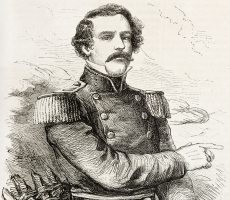Farby in Civil War Reenacting – Authentic Living History
An Introduction to Farby – by Kathleen Smith
Can you choose a book by its cover? Do first impressions really matter?
Hard-core Civil War reenactors will answer: you can and they do.
Reenactors, regardless of what period they choose to reenact, have to be very mindful of how they are perceived, not only by the public, but by their fellow reenactors as well. Most long-time reenactors will tell you, some more eagerly than others, when something is not correct or is non-period. And the worst critique that a Civil War reenactor can receive is to be told that they are “Farby.”
No one really knows where the term “Farby” originated, but most people believe it started when “thread-counters” (ultra hard-core reenactors who have an eye, and a mouth, for authenticity) would spy something wrong and say, “Far be it for me to say anything against what you are wearing, but that pin/brooch/fabric/plate/whatever is not period (i.e, correct) for the early 1860’s.”
At that point, the wearer feels a gamut of emotions, depending on the manner in which the criticism was given, anger, humiliation, extreme embarrassment, or perhaps enlightenment. Regardless, what you do with the information is important.
Reenactors get involved in the hobby for a variety of personal reasons. Some reenact to honor their ancestors who fought during the War Between the States. Other reenactors do so because they like to dress up and interact with the public (we all have a bit of ham in us!). But whatever the reason, reenactors must strive for authenticity in our attire, our accouterments, our speech and our surroundings; not doing so cheats the public out of a true and correct education of a tumultuous and definitive period of our nation’s history; for after all, we are “living historians.”
Nothing ruins a well-thought out dress more than a Farby piece. It’s a shame when someone has worked hard to achieve period-correct greatness only to ruin it with a pair of Foster Grants. Any modern eye wear, whether it be sunglasses or prescription eyeglasses, are considered Farby. What to do? Either have your prescription put into a pair of authentic 1860’s frames, use contacts, or walk around bumping into things!
But don’t despair. It’s just as easy to be Civil War period correct as it is to contribute to a Farbfest!
Browse the Internet (like the Library of Congress Civil War Photgraphs collection) or your public library to obtain the reenacting perfection each living historian desires. Look at photos of people and places during the 1860s. But don’t just look at their faces or the chairs they are sitting on; look at the table they’re sitting next to and the lamp on top and strive to copy and immulate everything! What were their tents and sleeping quarters like? What utensils did soldiers, sutlers and civilians use?
Make note of eye wear, hairstyles, fabric, rugs, wall-hangings, etc. What color fabrics were available at the time? Did women really wear hoop skirts all the time? Did most men have beards? How did Civil War era men and women wear their hair?
So much of it is in the details that we take for granted, like our watches. But those details are what most easily ruins an otherwise good impression. By becoming an expert on how the people of the 1860’s lived, you will automatically know when you (or those around you) are about to commit a “Farb-pas!”
Today’s learned living historians weren’t born knowing how to dress and act like a Civil War era person. We all learn as we go; we all take baby steps. And you need not become a Farbaholic, but you do want to experience the pride of knowing that your impression is truly “period” so that you contribute to the spectator’s sense that they have stepped back in time.
So, do some research. Talk to other reenactors who have done their homework. Learn from living historians who impressed you when you first met them. Listen, look, implement, and then, “Go, and Farb no more.”
